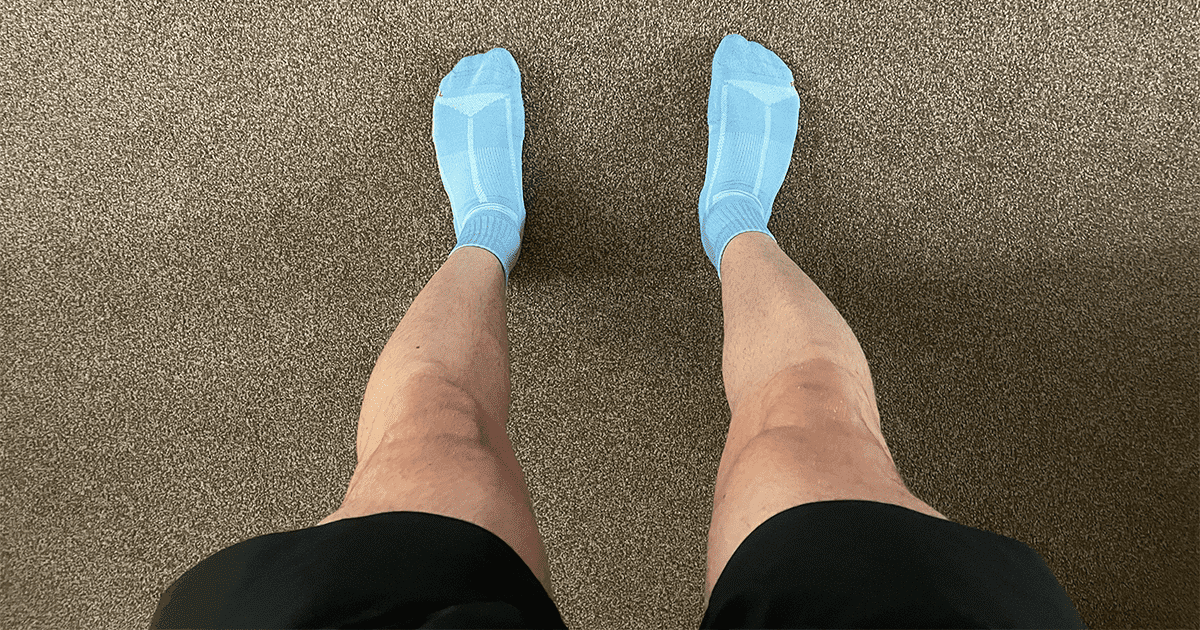Everything you need to know about running 5 miles a day
What are the benefits of running 5 miles a day? Is it a sensible goal? Will I lose weight? Here’s everything you need to know.

Running 5 miles a day is a goal that many people set themselves, whether they’re relatively new to running, or have been stomping the pavement for the last twenty years. Many people run for various different reasons, whether to lose weight, to get faster, to build endurance, or perhaps to clear their head after a difficult day.
Often, whether or not you should be running 5 miles a day is largely dependant on your goals. For example, if you’re uber serious about training, then there are likely better, perhaps more structured sessions available. But if you’re just doing it for fun, or perhaps looking to build fitness quickly, then you may be better be suited to the task.
If you haven’t run before, or ran in years, then running every day (for 5 miles) is not the best idea. Sorry to put it out there, but you run a high risk of injuring yourself, burning out, or losing motivation. It sucks, we know.
So, with this in mind, this blog post will discuss everything you need to know about running 5 miles a day, including whether or not it’s safe, the benefits, and tips to avoid burning out (and more).
[lwptoc numeration=”none” skipHeadingLevel=”h3,h4,h5,h6″]Is it okay to run 5 miles a day?
Whether or not you should be running 5 miles a day is largely dependant on your training history. If you are an inexperienced runner, we do not recommend running 5 miles a day. This will only increase your risk of injury.
Instead, we recommend performing three to four runs a week, following a training plan to see the best results. On the other hand, if you’re used to running high mileage weeks and have an extensive training background, then running 5 miles a day is a viable option. Below, we will discuss the many benefits of lacing up each day, so if that’s something you’re interested in, then keep reading.
What are the benefits of running 5 miles a day?
 As you have likely already figured, there are several benefits of running 5 miles a day. However, as aforementioned, this does depend on your level of experience and prior running history. For example, while one runner may come on leaps and bounds in their training, another may encounter an injury within the first or second week.
As you have likely already figured, there are several benefits of running 5 miles a day. However, as aforementioned, this does depend on your level of experience and prior running history. For example, while one runner may come on leaps and bounds in their training, another may encounter an injury within the first or second week.
Before highlighting the many benefits on offer, we should mention that there are also downsides, too. Mainly the increased risk of injury (especially for beginner runners). But more on the downsides shortly.
Benefits of running 5 miles a day include:
- Improved mental health and overall mood
- Better fitness and cardiovascular health
- Weight-loss (if this is your goal)
- Get into a routine
- Become an overall better runner
To help illustrate the many benefits of running 5 miles a day, we will now explain each of these points in more detail below:
Improved mental health and overall mood
Those who run regularly will likely benefit from improved mental health and an overall better mood. Running releases endorphins, these are also known as “feel-good hormones,” if you will. Not only that, but it provides you with goals, structure, and various other physical benefits.
Better fitness and cardiovascular health
Second, running 5 miles a day will improve your fitness and cardiovascular health. This is especially true if you haven’t done as much running or volume up until this point. So, while you may not necessarily increase your lactate threshold, you will increase your aerobic endurance, allowing you to run further with less effort.
Improved cardiovascular health is also a key benefit for many runners. There are very few exercises quite as good for the body (and the cardiovascular system) as grabbing a pair of shoes and heading out the door for your regular 5-mile loop.
Weight-loss (if this is your goal)
If you’re looking to lose weight, increasing the volume of your training is often the answer. However, this should be paired with a calorie deficit (consuming fewer calories than required). Usually, this deficit can be achieved strictly through exercise, so long as you are not consuming caloric heavy foods such as chocolate, crisps, ice cream, and other “unhealthy snacks” too often.
Weight loss, while simple in itself, can be a confusing and complex topic. For more information on losing weight through running, you can read our in-depth article by clicking here.
Get into a routine
Next up, running 5 miles a day will help you establish a healthy routine. According to James Clear, author of Atomic Habits, it takes approximately two months, or sixty-six days to develop new habits. Once you’re into a routine of running 5 miles a day, it will become much easier. Therefore, this makes chasing your goals much more straightforward, whether that’s running 5 miles a day for weight loss, to build endurance, or for other reasons, perhaps even clearing your head after a busy day at work.
So, if at first it’s difficult, stick with it and you’ll eventually build that lasting habit. However, don’t push it so much so that you develop an injury. Always listen to your body, even if that means running 5 miles a day four to five times a week instead of seven.
Become an overall better runner
 Finally, it’s no surprise that running more often allows you to become an overall better runner. If you’re relatively inexperienced or have taken some time off for a while, increasing your volume will help build that much-needed aerobic endurance.
Finally, it’s no surprise that running more often allows you to become an overall better runner. If you’re relatively inexperienced or have taken some time off for a while, increasing your volume will help build that much-needed aerobic endurance.
Despite this, you will not become a better runner if you encounter an injury. We cannot stress enough the need for rest in your training. So, yes, while running 5 miles a day may improve your fitness (among many other benefits), it’s no good if you get injured.
Are there any downsides?
Now that we’ve highlighted the many benefits of running 5 miles a day, let’s discuss the potential downsides.
Possible cons include:
- Injury
- Overtraining
- Less time to perform other types of training (e.g. cycling or lifting weights)
Once again, these downsides of running 5 miles a day will now be explained in greater detail below:
Injury
We have discussed the risk of injury in detail already. However, this risk should not be overlooked. If you are an inexperienced runner, then we do not recommend running 5 miles a day. Instead, it is far more worthwhile to run three or four times a week following a structured training program.
Within this program, sessions are likely to include two easy runs, one interval session, and one long run. This will allow you to become fitter, less injury-prone, and able to run longer distances. Moreover, if you would then later like to run 5 miles a day (once you have built this fitness), then it would be much safer and a more viable training option.
Overtraining
Finally, we have also touched upon this briefly, but the risk of overtraining by running 5 miles a day is much greater in comparison to running four or five times a week. The symptoms of overtraining may not appear straight away. Often, by this point, it is too late. Therefore, it’s essential to follow a balanced training program.
If you do become overtrained, we recommend taking two weeks off from running (and other sports). Ideally, this should be plenty of time to rest your body and motivation (if you catch it early).
Less type to perform other types of training
 Often, many people forget the importance of cross-training. Examples of cross-training include lifting weights, cycling, swimming, rowing, and various other sports. However, you may be wondering: what’s the point of cross-training if you’re trying to become a better runner? Well, cross-training is great on active rest days to speed up the recovery process. Also, activities such as lifting weights will improve your running strength and speed, and will also reduce your risk of injury by strengthing your muscles to prevent imbalances.
Often, many people forget the importance of cross-training. Examples of cross-training include lifting weights, cycling, swimming, rowing, and various other sports. However, you may be wondering: what’s the point of cross-training if you’re trying to become a better runner? Well, cross-training is great on active rest days to speed up the recovery process. Also, activities such as lifting weights will improve your running strength and speed, and will also reduce your risk of injury by strengthing your muscles to prevent imbalances.
Make sure to include rest days when running 5 miles a day
While running 5 miles a day may be a reasonable target for some runners, you should not neglect the importance of rest. At the very least, you should take one rest day per week. This can include either a full rest day (no activity) or at the most, light cardio such as cycling or a swim.
Rest is just as important for building fitness as doing the exercise itself. This is when your body adapts to your training, recovering, repairing, and making much-needed adaptions. So, no matter how many miles a day you run, or what training plan you follow, ensure to rest once in a while. Believe us, your body will thank you for it.
Tips to avoid burning out when running 5 miles a day
The more volume of training you perform, the more likely you are to either encounter an injury, or general overtraining or burnout. Overtraining may include injury, but may also comprise of a lack of energy, fatigue, a loss of appetite, increased soreness, and other symptoms.
There are numerous things you can do to avoid overtraining. The most obvious would be to train less, perhaps four of five days a week with two or three days of rest or active recovery. Furthermore, regular stretching is a must, paired with a balanced diet, plenty of protein, and time to detach from your training.
To summarise
Many runners take pride in running 5 miles (or more) a day. However, for many runners, this is not the best option for building fitness, at least without encountering an overuse injury. Despite this, if you are relatively experienced, you may benefit from lacing up each day.
Whatever training frequency you choose, do not neglect the importance of rest. Stretch, eat plenty of protein, and always listen to your body and you’ll be just fine!

Matthew is a lifelong runner, chief tester of all products, the founder of Running101, and freelance content writer for active brands. When he’s not writing, he enjoys lifting weights, cycling in the Lake District, and watching fast cars drive in circles on a Sunday. He also has a BA in sport, exercise and physical activity from the University of Durham.




